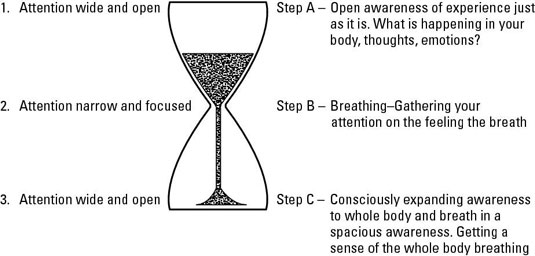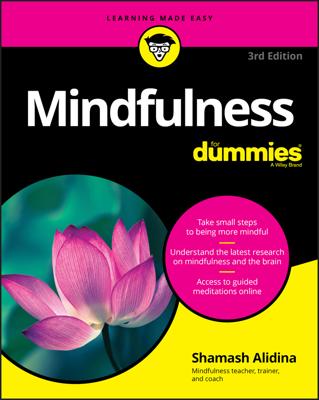The meditation is made up of three distinct stages. Think of these as A, B and C to help you to remember what to practice at each stage. The exercise doesn’t have to last exactly three minutes – you can make it longer or shorter depending on where you are and how much time you have. Follow these steps:
-
Sit upright with a sense of dignity, but don’t strain your back and neck.
If you can’t sit upright, try standing upright; lying down on your back or even curling up is acceptable. Sitting up straight is helpful because it sends a positive message to the brain.
-
Practice the A step for about a minute or so, then move on to B for a minute, ending with C also for a minute – or however long you can manage.
Step A: Awareness. Reflect on the following questions, pausing for a few seconds between each one:
-
What bodily sensations are you aware of at the moment? Feel your posture, become aware of any aches or pains, or any pleasant sensations. Just accept them as they are, as far as you can.
-
What emotions are you aware of at the moment? Notice the feelings in your heart or belly area or wherever you can feel emotion.
-
What thoughts are you aware of, passing through your mind at the moment? Become aware of your thoughts, and the space between you and your thoughts.
Step B: Breathing. Focus your attention in your belly area, the lower abdomen. As best you can, feel the whole of your in-breath and the whole of each out-breath. You don’t need to change the rate of your breathing – just become mindful of it in a warm, curious and friendly way. If your mind wanders away, gently and kindly guide your attention back to your breath.
Step C: Consciously expanding. Consciously expand your awareness from your belly to your whole body. Get a sense of your entire body breathing. As the energy settles in your body, notice its effect. Accept yourself as perfect and complete just as you are, just in this moment, as much as you can.
-
-
You move into a restful ‘being’ mode of mind. Your mind can be in one of two very different states of mind: doing mode or being mode. Doing mode is energetic and all about carrying out actions and changing things. Being mode is a soothing state of mind where you acknowledge things as they are.
-
Your self-awareness increases. You become more aware of how your body feels, the thoughts going through your mind and the emotion or need of the moment. You may notice that your shoulders are hunched, or your jaw is clenched. You may have thoughts whizzing through your head. If you listen to these messages, you can take appropriate action. Without self-awareness, you can’t tackle them.
-
You create more opportunities to make choices. You make choices all the time. Later on you may choose to go for a walk, call a friend or cook dinner. If your partner snaps at you, your reaction is a choice to a certain extent too. By practicing the breathing space, you stand back from your experiences and see the bigger picture of the situation you’re in.
-
You switch off automatic pilot. Have you ever eaten a whole meal and realized that you didn’t actually taste it? You were most likely on automatic pilot. You’re so used to eating, you can do it while thinking about other things. The breathing space helps to connect you with your senses so that you’re alive to the moment.
Try this thought experiment. Without looking, remember if your wrist watch has roman numerals or normal numbers on it. If you’re not sure, or got it wrong, it’s a small indication of how you’re operating on automatic pilot. You’ve looked at your watch hundreds of times, but not really looked carefully.
-
You become an observer of your experience rather than feeling trapped by it. In your normal everyday experience, no distance exists between you and your thoughts or emotions. They just arise and you act on them almost without noticing. One of the key outcomes of the breathing space is the creation of a space between you and your inner world.
-
You see things from a different perspective. Have you ever taken a comment too personally? Maybe, you immediately react, or at least feel a surge of emotion in the pit of your stomach. But you have other ways of reacting. The pause offered by the breathing space can help you see things in another way.
-
You walk the bridge between formal and informal practice. Formal practice is where you carve time in the day to practice meditation. Informal practice is being mindful of your normal activities. The breathing space is a very useful way of bridging the gap. The breathing space is both a formal practice because you’re making time to carry it out, and informal because you integrate it into your daily activities.
-
You create a space for new ideas to arise. By stopping your normal, everyday activities to practice the breathing space, you create room in your mind for other things to pop in. If your mind is cluttered, you can’t think clearly. The breathing space may be just what the doctor ordered to allow an intelligent insight or creative idea to pop into your mind.


